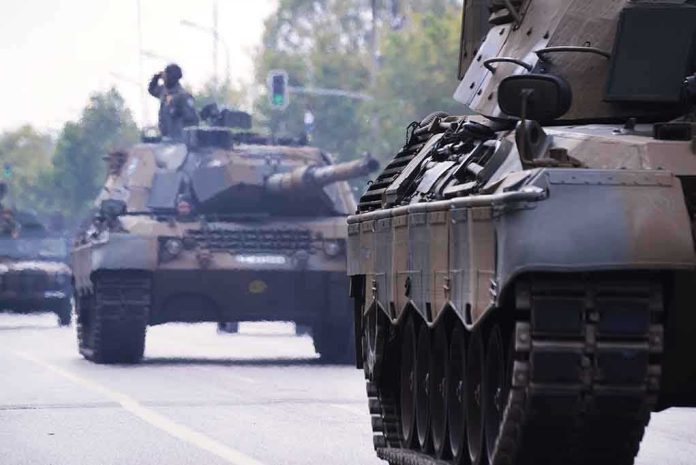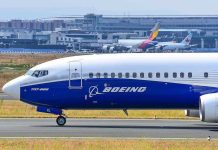
As Taiwan’s brand new U.S.-made Abrams tanks roared across Hsinchu County, President Lai watched on, sending a signal Beijing—and the world—couldn’t possibly miss: Taiwan’s not backing down, and neither are its allies.
At a Glance
- Taiwan showcased its U.S.-supplied Abrams M1A2T tanks in live-fire drills, flexing upgraded firepower in the face of Chinese military threats.
- President Lai Ching-te presided over the exercise, emphasizing the need for a strong military to secure both Taiwan and the Indo-Pacific region.
- China condemned the drills as provocation, continuing its own saber-rattling and military maneuvers amid escalating cross-strait tensions.
- The drills highlight a deepening U.S.-Taiwan partnership and send a message to Beijing about the consequences of further aggression.
U.S. Tanks, Taiwanese Resolve: Armor Meets Iron Will
Four gleaming Abrams M1A2T tanks—America’s finest—took center stage at Taiwan’s largest-ever Han Kuang military exercise, blasting both stationary and moving targets with clinical precision. President Lai Ching-te stood front and center, not hiding in the background, but openly affirming his government’s commitment to stronger defense. The symbolism was thick enough to cut with a bayonet: a democratically elected leader, staring down communist threats with American steel at his back. The drills, held at Kengzikou training range just south of Taipei, mark a significant escalation in both capability and message. While some leaders cower behind diplomatic double-speak, Taiwan is betting its survival on readiness and backbone.
These live-fire maneuvers weren’t just about showing off hardware. They were a deliberate reminder that freedom, security, and sovereignty don’t come cheap—and certainly not by appeasing bullies. The Abrams tanks, delivered just months ago as part of a $1.45 billion U.S. package, fired individually, in pairs, and as a platoon, reportedly achieving 100% accuracy. That’s the kind of performance you want in your corner when a hostile neighbor is forever flexing its muscle just across the strait.
China Seethes, U.S.-Taiwan Alliance Deepens
China’s reaction was as predictable as it was melodramatic. Beijing condemned the drills as a “farce,” lobbing accusations of provocation while refusing to acknowledge its own routine incursions into Taiwanese airspace and waters. The irony is almost too rich to stomach: the world’s biggest authoritarian regime, terrified by a handful of tanks and a free people’s determination to defend their homeland. But that’s the point—these drills are about more than just firepower. They are about signaling to the world, and to the U.S. in particular, that Taiwan isn’t rolling over. The message to Beijing? The days of easy intimidation are over.
President Lai didn’t mince words. He called the exercises “large-scale, realistic combat drills,” arguing that a strong military is the only way to guarantee peace and stability—not just for Taiwan, but for the entire Indo-Pacific. The U.S.-Taiwan security relationship, codified since the 1979 Taiwan Relations Act, has never looked more relevant. As the U.S. Congress continues to debate arms sales and support packages, the sight of American tanks in action on Taiwanese soil will no doubt sharpen those discussions. It’s a partnership rooted in shared values—and a shared recognition that appeasement only invites aggression.
Escalation or Deterrence? The Stakes for Freedom
The Han Kuang 41 exercises are the longest and most comprehensive in Taiwan’s history—a direct response to Beijing’s escalating military pressure and constant gray-zone tactics. These aren’t just war games; they’re a dress rehearsal for the kind of invasion scenario that, if left unchecked, could spiral into a global conflict. The integration of Abrams tanks, alongside U.S.-supplied F-16V fighter jets and HIMARS missile systems, represents a quantum leap in Taiwan’s ground force capabilities. Military analysts say these upgrades will make a real difference if push ever comes to shove, especially in countering the armored and amphibious threats the PLA loves to parade in propaganda videos.
This is not just Taiwan’s fight. It’s a fight for every nation that values self-determination over subjugation, rule of law over rule by fear. As China continues to test the world’s resolve—from the South China Sea to cyberwarfare—Taiwan’s drills are a blunt reminder that freedom requires both courage and teeth. Yes, the risk of escalation is real. But the risk of doing nothing, of letting intimidation go unchallenged? That’s how nations—and the values they hold dear—are lost.









